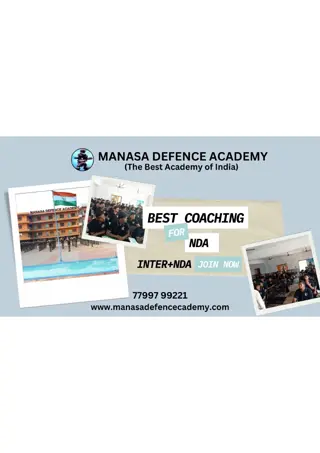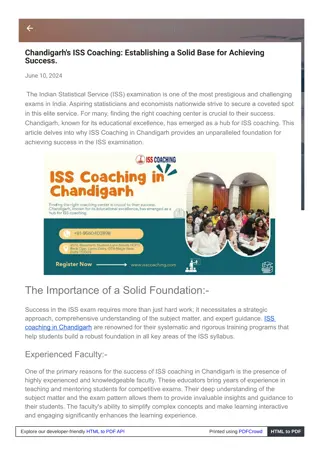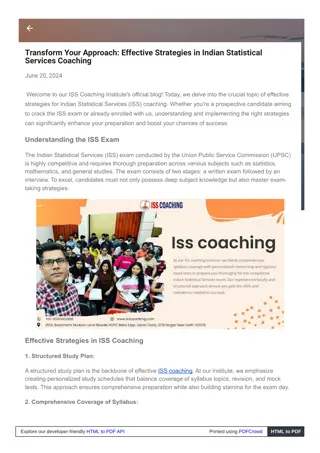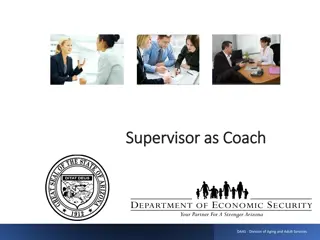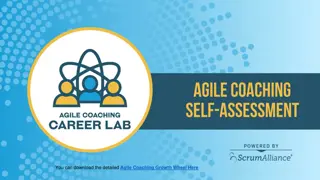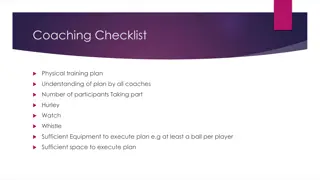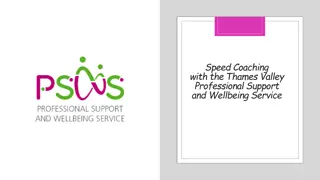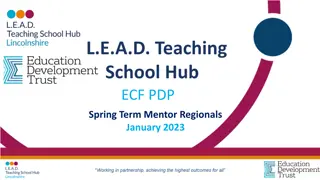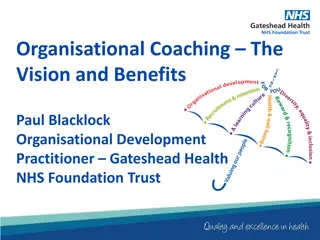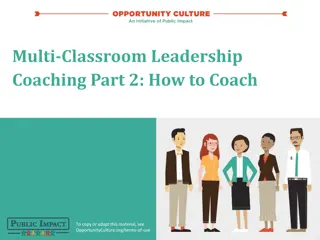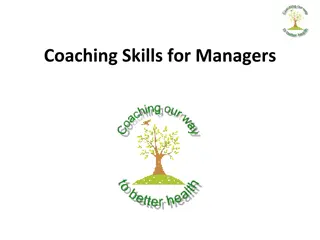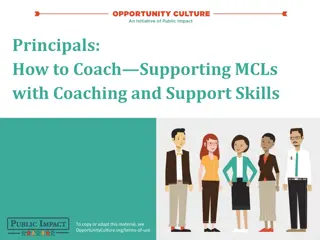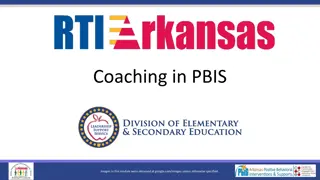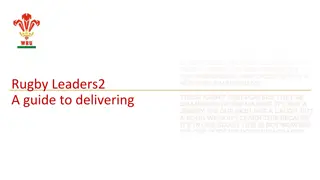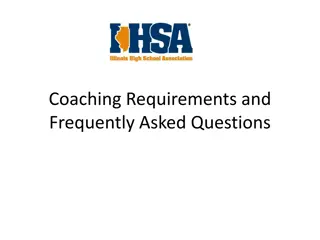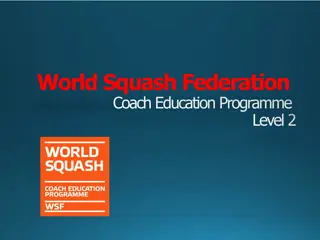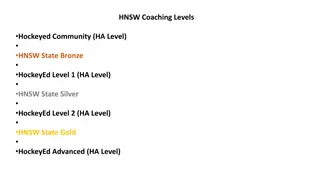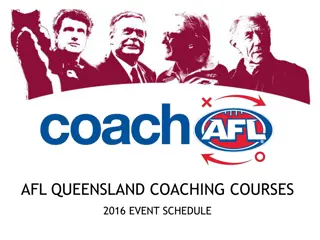Supporting Teachers through Effective Coaching Strategies
Explore the intricacies of coaching in education through Janice Creneti's insightful session on meeting teachers where they are to propel them forward. Discover the essence of instructional coaching, adult learning principles, and the Strategic Instruction ModelTM. Learn about what effective coaches do, the importance of listening, and how coaching differs from other practices. Gain valuable insights into empowering educators, championing change, and fostering equity in educational settings.
- Coaching in education
- Effective coaching strategies
- Professional development
- Instructional support
- Empowering educators
Download Presentation

Please find below an Image/Link to download the presentation.
The content on the website is provided AS IS for your information and personal use only. It may not be sold, licensed, or shared on other websites without obtaining consent from the author. Download presentation by click this link. If you encounter any issues during the download, it is possible that the publisher has removed the file from their server.
E N D
Presentation Transcript
COACHING SIM: How to Meet Teachers Where They Are to Support Them in Moving Forward Janice Creneti Assistant Manager, Florida SPDG SIM Project
What do you want to know? If there is something specific you are interested in learning about or discussing during this session, please write it on a sticky note and hand it to Janice.
Our Learning Journey around Coaching What (it is and is not) Why? Who? How Current Reality & Goals Florida SPDG Coaching Structures Necessary Conditions Advocacy Wrap-up HLP Connections Evaluations
Expertise: Instructional Coaching, Adult Learning Principles, SIMTM Content Enhancement Routines, Content Areas: Science, Math, CTE Favorite Routines: Course Organizer, Unit Organizer, Clarifying, Concept Mastery, Question Exploration Passions: Empowering educators & students, Championing change, The Strategic Instruction ModelTM (SIM), Equity, Theater - acting, directing, Nature & Animals Janice Creneti Assistant Manager, SPDG SIM Project, SIM CE PDer Office: (727)588-6523 Cell: (941)518-5718 crenetij@pcsb.org
What are your experiences with coaching? The good and the not so good...
Coaching... looks like does not look like Job embedded professional learning driven by the learner An expert telling a novice what to do Evaluating (summative) practice A journey to best practice (fidelity) Decision making guided by data Decision making guided by emotion One peer supports another peer in identifying and reaching (or moving toward) a goal around implementation of a practice Enforcing, spying, coercing, bribing, commiserating A reciprocal relationship based on trust
What do effective coaches do? Listen first and most of the time
Clarifying Table Instructional Coaching Be prepared to educate others on coaching This may involve myth busting
Coaching is about preserving (or reinstating) educator Voice & Choice* *Partnership Principles, Jim Knight, www.instructionalcoach.org
Jim Knight & the Instructional Coaching Group Instructional Coaching High Impact Instruction The Impact Cycle Focus on Learning Better Conversations Radical Learners Blog www.instructionalcoaching.com/radical-learners/
Why Coaching? State of the profession High turnover = lots of new teachers Career Changers Hierarchical system when collaboration is needed Teachers are buried under multiple expectations Adult learner needs Job embedded PD Praxis
Who Coaches Instruction? Instructional Coaches SIM PDers Administrators Fellow Teachers!!!
What does coaching for SIM look like? What have you seen? Think, Pair, Square
Support the teacher in getting a clear picture of current reality (gotta know where you are to know where to go )
Coach around the teacher s goal (and support the journey to get there)
Talk about what worked and what to change up next time (the teacher drives this discussion) Check out Jim Knight s The Impact Cycle for details on his model.
Coaching Structures used by the Florida SPDG SIM Project Florida SPDG SIM Coaching Resources LiveBinder https://www.livebinders.com/b/2569356 Access Key: SPDGSIMIC
Face-to-face Coaching Cycles Pros: relationship building, real time support 2 days Coach is a SIM PDer Day 1: coach meets w/ teacher during planning Goal setting Decisions about what to try in class the next day Cons: hard to schedule, not always enough manpower Day 2: coach is with teacher in the classroom Modeling or observation Debrief afterwards or plan is made to debrief
Evidence Submission Coaching Pros: able to coach teacher on application, coaches can work any time Coach is a SIM PDer Content Enhancement Evidence: Teacher draft Student Sample Reflection Con: feedback may be delayed Learning Strategies Evidence Scored Learning Sheets Reflection
Implementation Observations Pros: video is easy to schedule, teachers have a clear target Only after 1 full year of implementation Coach is a SIM PDer In person or video Con: may be perceived as evaluative CE: Guided by the Cue Do Review checklist LS: Guided by modeling checklist or student folder checklist
Face-to-face Coaching Cycles 2 days Pros: relationship building, real time support Coach is a SIM PDer Day 1: coach meets w/ teacher during planning Goal setting Decisions about what to try in class the next day Cons: hard to schedule, need manpower Day 2: coach is with teacher in the classroom Modeling or observation Debrief afterwards or plan is made to debrief
Facilitated Planning During or after contract hours Facilitator is a SIM PDer/Specialist Content Enhancement: Teachers develop or revise devices, extensions Reflect on and plan for Cue-Do-Review Troubleshoot concerns Learning Strategies: Teachers score or review scoring of pretests, learning sheets Reflect on and plan for think alouds, modeling, 3 to 1 interactions Troubleshoot concerns including managing materials Pros: relationship building, real time support Cons: may require $$$
Lesson Study Pros: builds collegiality, allows teachers to watch students Group of teachers who teach the same or similar class + invested other Facilitator is a SIM PDer/Specialist Done over 1 or 2 days Cons: time and resource intensive Whole team involved in planning the lesson Whole team OBSERVES the lesson (data collection including the instructional sequence) Often our facilitator teaches the lesson
Coaching Summits & Seminars Why: Build capacity for coaching by supporting teachers and instructional coaches in coaching SIM even if they are not PDers Build a common vocabulary, skill set and clear picture of effective coaching What: Provide PD on Instructional Coaching 1.5 2 days Cross district Opportunities to practice coaching SIM Adding Systems Coaching
Talk at Your Tables Did you see a model you might want to explore? How might you tweak it for your situation? How might you address the cons ? Choose a table member to share your team brilliance with the whole group Share outs
Building Trust True coaching only happens inside a positive, safe relationship SO... Be reliable Be honest Be caring/practice empathy Maintain confidentiality Hold and nurture the possible
Coaching success requires a system (including leadership) that creates safe space
7 Success Factors for Coaching (the environment in which coaching happens) 1. Coaching Cycle (how will coaching happen?) Knight, Jim. Seven Success Factors for Instructional Coaching Programs. Principal Leadership, March 2015: pgs 24-27 2. Understanding Adults 3. Playbook (what are we coaching around?) 4. Using Data 5. Communication 6. Leadership Responsive & Reliable 7. System Support
Advocating for Coaching Why this is necessary May involve myth busting and clarifying Draw connections to professional development Use data as local as you can as recent as you can Use stories from teachers from students
HLP 11 Instruction: Identify and prioritize long and short term learning goals Connections to HLPs for Special Education HLP 12 Instruction: Systematically design instruction toward a specific learning goal HLP14 Teach cognitive and metacognitive strategies to support learning and independence. HLP1 Collaborate with professionals to increase student success. HLP2 Collaboration: Organize and facilitate effective meetings with professionals and families HLP5 Interpret and communicate assessment information with stakeholders to collaboratively design and implement educational programs. HLP6 Use student assessment data, analyze instructional practices, and make necessary adjustments that improve student outcomes. HLP15 Provide scaffolded supports. HLP16 Use explicit instruction. HLP18 Use strategies to promote active student engagement. HLP20 Provide positive and constructive feedback to guide students learning and behavior. HLP21 Teach students to maintain and generalize new learning across time and settings. HLP22 Provide intensive instruction.
Connections to HLPs for General Education HLP 2: Explaining and modeling content, practices, and strategies HLP 4: Diagnosing particular common patterns of student thinking and development in a subject-matter domain HLP 5: Implementing norms and routines for classroom discourse and work HLP 6: Coordinating and adjusting instruction during a lesson HLP 8: Implementing organizational routines HLP 13: Setting ling and short term learning goals for students HLP 14: Designing single lessons and sequences of lessons HLP 16: Selecting and designing formal assessments for student learning HLP 17: Interpreting the results of student work, including routine assignments, quizzes, test, projects, an standardized assessments HLP 19: Analyzing instruction for the purpose of improving it
Please go to the link below to evaluate this session: https://www.surveymonkey.com/r/2019SIMposium Or scan the Evaluation barcode (also found on your SIM Conference Program)
Exit Ticket Please reflect on today and tell us... What's working for you? What adjustments would you like us to make?



